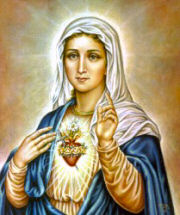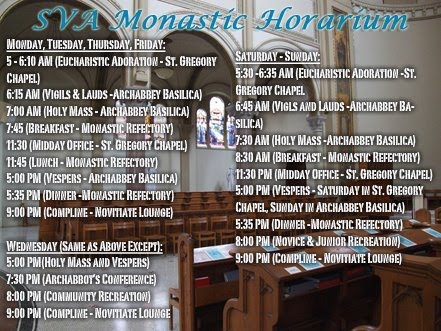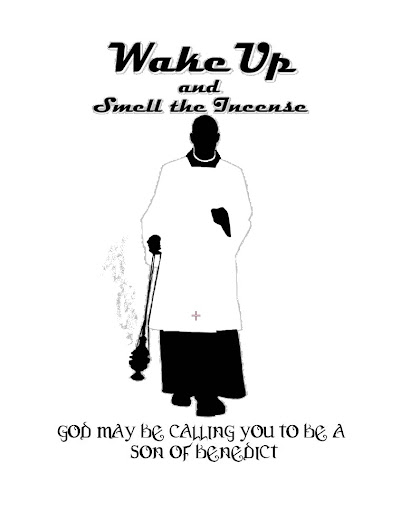Isolated missionary groups had penetrated central Germany in earlier times, but not until the eighth century was there a systematic effort to Christianize the vast pagan wilderness. To the English monk Boniface belongs the honor of opening up this region and creating a hierarchy under direct commission from the Holy See. Thirty-six years of missionary labor under difficult and dangerous conditions, ending at last in martyrdom, entitle this good and courageous man to the designation, "Apostle of Germany."
Boniface, or Winfrid, to give him his baptismal name, was born into a Christian family of noble rank, probably at Crediton in Devonshire, about the year 680. The reorganized English Church, still under the inspiration brought to it from Rome two generations earlier by Augustine of Canterbury, was full of fervor and vitality. Winfrid was a very small boy when he found himself listening to the conversation of some monks who were visiting his home. He resolved then to enter the Church, and this resolution never weakened. Winfrid's father had other plans for his clever son, but a serious illness altered his attitude, and he sent the boy to the neighboring abbey of Exeter to be educated. Some years later, Winfrid went to the abbey of Bursling, in the diocese of Winchester. After completing his studies there, he was appointed head of the school.
His teaching skill attracted many students, and for their use he wrote a grammar which is still extant. The pupils diligently took notes at his classes, and these were copied and circulated in other monasteries, where they were eagerly studied. At the age of thirty he was ordained priest, and now added preaching to teaching and administrative work.
Winfrid was assured of rapid advancement in the English Church, but God revealed to him that his work was to be in foreign lands, where need was greater. Northern Europe and most of Central Europe were still in pagan darkness. In Friesland, which then included modern Netherlands and lands to the east, the Northumbrian missionary Willibrord had long been striving to bring the Gospel to the people. It was to this region that Winfrid felt himself called. Having obtained the consent of his abbot, he and two companions set out in the spring of 716. Soon after landing at Doerstadt they learned that Duke Radbold of Friesland, an enemy of Christianity, was warring with Charles Martel, the Frankish duke, and that Willibrord had been obliged to retire to his monastery at Echternacht. Realizing that the time was inauspicious, the missionaries prudently returned to England in the autumn. Winfrid's monks at Bursling tried to keep him there, and wished to elect him abbot, but he was not to be turned from his purpose.
.jpg)
This first attempt had shown him that to be effective as a missionary he must have a direct commission from the Pope, so in 718, with commendatory letters from the bishop of Winchester, he presented himself in Rome before Gregory II. The Pope welcomed him warmly, kept him in Rome until spring of the following year, when traveling conditions were favorable, and then sent him forth with a general commission to preach the word of God to the heathen. At this time Winfrid's name was changed to Boniface (from the Latin, , fortunate). Crossing the lower Alps, the missionary traveled through Bavaria into Hesse. Duke Radbold had died and his successor was more friendly. Going into Friesland, Boniface labored for three years under Willibrord, who was now very old. Boniface declined to become Willibrord's coadjutor and successor as bishop of Utrecht, saying that his commission had been general, "to the heathen," and he could not be limited to any one diocese. He now returned to work in Hesse.
Boniface had little difficulty in making himself understood as a preacher, since the dialects of the various Teutonic tribes closely resembled his native Anglo-Saxon. He won the interest of two powerful local chieftains, Dettic and Deorulf, who at some previous time had been baptized. For lack of instruction they had remained little better than pagans; now they became zealous Christians and influenced many others to be baptized. They also gave Boniface a grant of land on which he later founded the monastery of Amoeneburg. Boniface was able to report such remarkable gains that the Pope summoned him back to Rome to be ordained bishop.
In Rome on St. Andrew's Day, November 30, 722, Pope Gregory II consecrated him as regionary bishop with a general jurisdiction over "the races in the parts of Germany and east of the Rhine who live in error, in the shadow of death." The Pope also gave him a letter to the powerful Charles Martel, "The Hammer." When Boniface delivered it to the Frankish duke on his way back to Germany, he received the valuable gift of a sealed pledge of Frankish protection. Armed thus with authority from both the Church and the civil power, the prestige of Boniface was vastly enhanced. On his return to Hesse, he decided to try to root out the pagan superstitions which seriously affected the stability of his converts. On a day publicly announced, and in the midst of an awe-struck crowd, Boniface and one or two of his followers attacked with axes Thor's sacred oak. These German tribes, along with many other primitive peoples, were tree-worshipers. Thor, god of thunder, was one of the principal Teutonic deities, and this ancient oak, which stood on the summit of Mt. Gudenberg, was sacred to him. After a few blows, the huge tree crashed to earth, splitting into four parts. The terrified tribesmen, who had expected a punishment to fall instantly on the perpetrators of such an outrage, now saw that their god was powerless to protect even his own sanctuary.
To signalize the victory, Boniface built a chapel on the spot. From that time the work of evangelization in Hesse proceeded steadily.
.jpg) Moving east into Thuringia, Boniface continued his crusade. He found a few undisciplined Celtic and Irish priests, who tended to be a hindrance; many of them held heretical beliefs and others lived immoral lives. Boniface restored order among them, although his chief aim was to win over the pagan tribes. At Ohrdruff, near Gotha, he established a second monastery, dedicated to St. Michael, as a missionary center. Everywhere the people were ready to listen, but there was a critical lack of teachers. Boniface appealed to the English monasteries and convents, and their response was so wholehearted that for several years bands of monks, schoolmasters, and nuns came over to place themselves under his direction. The two monasteries already built were enlarged and new ones founded. Among the new English missionaries were Lullus, who was to succeed Boniface at Mainz, Eoban, who was to share his martyrdom, Burchard, and Wigbert; the nuns included Thecla, Chunitrude, and Boniface's beautiful and learned young cousin, Lioba, later to become abbess of Bischofsheim and friend of Hildegarde, Charlemagne's wife.
Moving east into Thuringia, Boniface continued his crusade. He found a few undisciplined Celtic and Irish priests, who tended to be a hindrance; many of them held heretical beliefs and others lived immoral lives. Boniface restored order among them, although his chief aim was to win over the pagan tribes. At Ohrdruff, near Gotha, he established a second monastery, dedicated to St. Michael, as a missionary center. Everywhere the people were ready to listen, but there was a critical lack of teachers. Boniface appealed to the English monasteries and convents, and their response was so wholehearted that for several years bands of monks, schoolmasters, and nuns came over to place themselves under his direction. The two monasteries already built were enlarged and new ones founded. Among the new English missionaries were Lullus, who was to succeed Boniface at Mainz, Eoban, who was to share his martyrdom, Burchard, and Wigbert; the nuns included Thecla, Chunitrude, and Boniface's beautiful and learned young cousin, Lioba, later to become abbess of Bischofsheim and friend of Hildegarde, Charlemagne's wife.
Pope Gregory III sent Boniface the pallium in 731, appointing him archbishop and metropolitan of all Germany beyond the Rhine, with authority to found new bishoprics. A few years later Boniface made his third trip to Rome to confer about the churches he had founded, and at this time he was appointed apostolic legate. Stopping at Monte Cassino, he enlisted more missionaries. In his capacity as legate he traveled into Bavaria to organize the Church there into the four bishoprics of Regensburg, Freising, Salzburg, and Passau. From Bavaria he returned to his own field and founded new bishoprics at Erfurt for Thuringia, Buraburg for Hesse, Wurzburg for Franconia, and Eichstadt for the Nordgau. An English monk was placed at the head of each new diocese. In 741 the great Benedictine abbey at Fulda was founded in Prussia to serve as the fountainhead of German monastic culture. Its first abbot was Boniface's young Bavarian disciple, Sturm or Sturmio. In the early Middle Ages Fulda produced a host of scholars and teachers, and became known as the Monte Cassino of Germany.
.jpg) While the evangelization of Germany was proceeding steadily, the Church in Gaul, under the Merovingian kings, was disintegrating. High ecclesiastical offices were either kept vacant, sold to the highest bidder, or bestowed on unworthy favorites. Pluralism, the holding by one man of many offices, each of which should demand his full time, was common. The great mass of the clergy was ignorant and undisciplined. No synod or church council had been held for eighty-four years. Charles Martel had been conquering and consolidating the regions of western Europe, and now regarded himself as an ally of the papacy and the chief champion of the Church, yet he had persistently plundered it to obtain funds for his wars and did nothing to help the work of reform. His death, however, in 74I, and the accession of his sons, Carloman and Pepin the Short, provided an opportunity which Boniface quickly seized. Carloman, the elder, was very devout and held Boniface in great veneration; Boniface had no trouble in persuading him to call a synod to deal with errors and abuses in the Church in Austrasia, Alemannia, and Thuringia.
While the evangelization of Germany was proceeding steadily, the Church in Gaul, under the Merovingian kings, was disintegrating. High ecclesiastical offices were either kept vacant, sold to the highest bidder, or bestowed on unworthy favorites. Pluralism, the holding by one man of many offices, each of which should demand his full time, was common. The great mass of the clergy was ignorant and undisciplined. No synod or church council had been held for eighty-four years. Charles Martel had been conquering and consolidating the regions of western Europe, and now regarded himself as an ally of the papacy and the chief champion of the Church, yet he had persistently plundered it to obtain funds for his wars and did nothing to help the work of reform. His death, however, in 74I, and the accession of his sons, Carloman and Pepin the Short, provided an opportunity which Boniface quickly seized. Carloman, the elder, was very devout and held Boniface in great veneration; Boniface had no trouble in persuading him to call a synod to deal with errors and abuses in the Church in Austrasia, Alemannia, and Thuringia.
The first assembly was followed by several others. Boniface presided over them all, and was able to carry through many important reforms. The vacant bishoprics and parishes were filled, discipline reestablished, and fresh vigor infused into the Frankish Church.
A heretic who had been creating much disturbance, one Adalbert of Neustria, was condemned by the synod of Soissons in 744. In 747 another general council of the Frankish clergy drew up a profession of faith and fidelity which was sent to Rome and laid upon the altar in the crypt of St. Peter's. After five years' labor Boniface had succeeded in restoring the Church of Gaul to its former greatness.
Now Boniface desired that Britain too should share in this reform movement. At his request and that of Pope Zacharias, the archbishop of Canterbury held a council at Clovesho, in 747, which adopted many of the resolutions passed in Gaul. This was also the year when Boniface was given a metropolitan see. Cologne was at first proposed as his cathedral city, but Mainz was finally chosen. Even when Cologne and other cities became archiepiscopal sees, Mainz retained the primacy. The Pope also made Boniface primate of Germany as well as apostolic legate for both Germany and Gaul.
 Carloman now retired to a monastery, but his successor, Pepin, who brought all Gaul under his control, gave Boniface his support. "Without the patronage of the Frankish chiefs," Boniface wrote in a letter to England, "I cannot govern the people or exercise discipline over the clergy and monks, or check the practice of paganism." As apostolic legate, Boniface crowned Pepin at Soissons in 75I, thus giving papal sanction to the assumption of royal power by the father of Charlemagne. Boniface, beginning to feel the weight of his years, made Lullus his coadjutor. Yet even now, when he was past seventy, his missionary zeal burned ardently. He wished to spend his last years laboring among those first converts in Friesland, who, since Willibrord's death, were relapsing once more into paganism. Leaving all things in order for Lullus, who was to become his successor, he embarked with some fifty companions and sailed down the Rhine. At Utrecht the party was joined by Eoban, bishop of that diocese. They set to work reclaiming the relapsed Christians, and during the following months made fruitful contact with the hitherto untouched tribes to the northeast. Boniface arranged to hold a great confirmation service on Whitsun Eve on the plain of Dokkum, near the banks of the little river Borne.
Carloman now retired to a monastery, but his successor, Pepin, who brought all Gaul under his control, gave Boniface his support. "Without the patronage of the Frankish chiefs," Boniface wrote in a letter to England, "I cannot govern the people or exercise discipline over the clergy and monks, or check the practice of paganism." As apostolic legate, Boniface crowned Pepin at Soissons in 75I, thus giving papal sanction to the assumption of royal power by the father of Charlemagne. Boniface, beginning to feel the weight of his years, made Lullus his coadjutor. Yet even now, when he was past seventy, his missionary zeal burned ardently. He wished to spend his last years laboring among those first converts in Friesland, who, since Willibrord's death, were relapsing once more into paganism. Leaving all things in order for Lullus, who was to become his successor, he embarked with some fifty companions and sailed down the Rhine. At Utrecht the party was joined by Eoban, bishop of that diocese. They set to work reclaiming the relapsed Christians, and during the following months made fruitful contact with the hitherto untouched tribes to the northeast. Boniface arranged to hold a great confirmation service on Whitsun Eve on the plain of Dokkum, near the banks of the little river Borne.
While awaiting the arrival of the converts, Boniface was quietly reading in his tent.
Suddenly a band of armed pagans appeared in the center of the encampment. His companions would have tried to defend their leader, but Boniface would not allow them to do so. Even as he was telling them to trust in God and welcome the prospect of dying for Him, the Germans attacked. Boniface was one of the first to fall; his companions shared his fate. The pagans, expecting to carry away rich booty, were disgusted when they found, besides provisions, only a box of holy relics and a few books They did not bother to carry away these objects, which were later collected by the Christians who came to avenge the martyrs and rescue their remains. The body of Boniface was carried to Fulda for burial, and there it still rests. The book the bishop was reading and which he is said to have lifted above his head to save it when the blow fell is also one of Fulda's treasures.
Boniface has been called the pro-consul of the papacy. His administrative and organizing genius left its mark on the German Church throughout the Middle Ages.
Though Boniface was primarily a man of action, his literary remains are extensive.
Especially interesting and important from the point of view of Church dogma and history are his letters. Among the emblems of Boniface are an oak, an axe, a sword, a book.


















.jpg)

.jpg)

.jpg)
.jpg)
.jpg)







